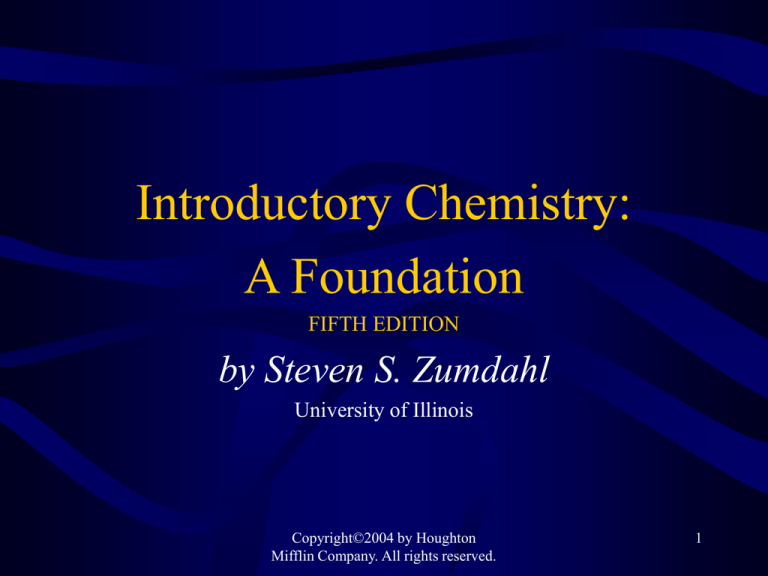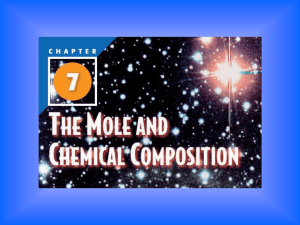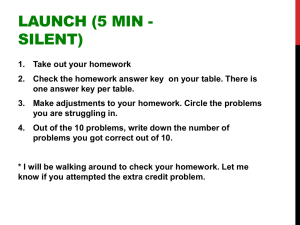
Introductory Chemistry:
A Foundation
FIFTH EDITION
by Steven S. Zumdahl
University of Illinois
Copyright©2004 by Houghton
Mifflin Company. All rights reserved.
1
Stoichiometry
Chapter 9
Copyright©2004 by Houghton
Mifflin Company. All rights reserved.
2
Stoichiometry
rules……..
Copyright©2004 by Houghton
Mifflin Company. All rights reserved.
3
Information Given by the
Chemical Equation
• Balanced equation provides the relationship
between the relative numbers of reacting
molecules and product molecules
2 CO + O2 2 CO2
2 CO molecules react with 1 O2 molecules to
produce 2 CO2 molecules
Copyright©2004 by Houghton
Mifflin Company. All rights reserved.
4
Information Given by the
Chemical Equation
• Since the information given is relative:
2 CO + O2 2 CO2
200 CO molecules react with 100 O2 molecules to produce
200 CO2 molecules
2 billion CO molecules react with 1 billion O2 molecules to
produce 2 billion CO2 molecules
2 moles CO molecules react with 1 mole O2 molecules to
produce 2 moles CO2 molecules
12 moles CO molecules react with 6 moles O2 molecules
to produce 12 moles CO2 molecules
Copyright©2004 by Houghton
Mifflin Company. All rights reserved.
5
Information Given by the
Chemical Equation
• The coefficients in the balanced chemical
equation shows the molecules and mole
ratio of the reactants and products
• Since moles can be converted to masses, we
can determine the mass ratio of the reactants
and products as well
Copyright©2004 by Houghton
Mifflin Company. All rights reserved.
6
Copyright©2004 by Houghton
Mifflin Company. All rights reserved.
7
Information Given by the
Chemical Equation
2 CO + O2 2 CO2
2 moles CO = 1mole O2 = 2 moles CO2
Since 1 mole of CO = 28.01 g, 1 mole O2 = 32.00 g,
and 1 mole CO2 = 44.01 g
2(28.01) g CO + 1(32.00) g O2 = 2(44.01) g CO2
Copyright©2004 by Houghton
Mifflin Company. All rights reserved.
8
Propane is often used as a fuel for
outdoor grills.
Copyright©2004 by Houghton
Mifflin Company. All rights reserved.
9
General Plan for
Stoichiometry Calculations
Mass
Known
Moles
Known
Use
Mole
Ratio
Moles
Unknown
Mass
unknown
Obtain mole ratio from balanced chemical equation
Copyright©2004 by Houghton
Mifflin Company. All rights reserved.
10
Example #1
Determine the Number of Moles of Carbon Monoxide
required to react with 3.2 moles Oxygen,
and determine the moles of Carbon Dioxide produced
Write the balanced equation
2 CO + O2 2 CO2
Use the coefficients to find the mole
relationship
2 moles CO = 1 mol O2 = 2 moles CO2
Copyright©2004 by Houghton
Mifflin Company. All rights reserved.
11
Example #1
Determine the Number of Moles of Carbon Monoxide
required to react with 3.2 moles Oxygen,
and determine the moles of Carbon Dioxide produced
Use dimensional analysis
3.2 moles O 2 x
2 moles CO
6.4 moles CO
1 mole O 2
3.2 moles O 2 x
2 moles CO
2
6.4 moles CO
2
1 mole O 2
Copyright©2004 by Houghton
Mifflin Company. All rights reserved.
12
Example #2
Determine the Number of grams of Carbon Monoxide
required to react with 48.0 g Oxygen,
and determine the mass of Carbon Dioxide produced
Write the balanced equation
2 CO + O2 2 CO2
Use the coefficients to find the mole relationship
2 moles CO = 1 mol O2 = 2 moles CO2
Determine the Molar Mass of each
1 mol CO = 28.01 g
1 mol O2 = 32.00 g
1 mol CO2 = 44.01 g
Copyright©2004 by Houghton
Mifflin Company. All rights reserved.
13
Example #2
Determine the Number of grams of Carbon Monoxide
required to react with 48.0 g Oxygen,
and determine the mass of Carbon Dioxide produced
Use the molar mass of the given quantity to
convert it to moles
° Use the mole relationship to convert the moles
of the given quantity to the moles of the desired
quantity
48.0 g O 2 x
1 mol O 2
x
32.00 g
48.0 g O 2 x
1 mol O 2
32.00 g
2 mol CO
1 mol O 2
x
2 mol CO 2
1 mol O 2
Copyright©2004 by Houghton
Mifflin Company. All rights reserved.
14
Example #2
Determine the Number of grams of Carbon Monoxide
required to react with 48.0 g Oxygen,
and determine the mass of Carbon Dioxide produced
±
Use the molar mass of the desired quantity to
convert the moles to mass
48.0 g O 2 x
48.0 g O 2 x
1 mol O 2
x
2 mol CO
x
28.01 g
32.00 g
1 mol O 2
1 mol CO
1 mol O 2
2 mol CO 2
44.01 g
32.00 g
x
1 mol O 2
x
84.0 g CO
132 g CO 2
1 mol CO 2
Copyright©2004 by Houghton
Mifflin Company. All rights reserved.
15
Calculate the number of moles of oxygen
required to react exactly with 4.30 moles
of propane, C3H8, in the reaction
described by the following equation….
C3H8 + 5O2 3CO2 + 4H2O
Copyright©2004 by Houghton
Mifflin Company. All rights reserved.
16
Butane, also a fuel, reacts with oxygen to
produce carbon dioxide and water.
C4H10 + O2 CO2 + H2O
What mass of oxygen will be required to
react exactly with 96.1 grams of butane?
Copyright©2004 by Houghton
Mifflin Company. All rights reserved.
17
Every day Examples:
• How many pairs of gloves can I make
from 20 left gloves and 30 right gloves?
• If I have five eggs and 5 brownie mixes
and each brownie mix needs two eggs,
how many batches of brownies can I
make?
• If I have 6 model car wheels, two
bodies, 10 bumpers, 4 engines, how
many model cars can I make?
Copyright©2004 by Houghton
Mifflin Company. All rights reserved.
18
Limiting Reactants
Reactants
2 NO(g) + O2 (g)
Products
2 NO2(g)
Limiting reactant = ___________
Excess reactant = ____________
Copyright©2004 by Houghton
Mifflin Company. All rights reserved.
19
Limiting and Excess Reactants
• A reactant which is completely consumed when a
reaction is run to completion is called a limiting
reactant
• A reactant which is not completely consumed in a
reaction is called an excess reactant
• The maximum amount of a product that can be made
when the limiting reactant is completely consumed is
called the theoretical yield
Copyright©2004 by Houghton
Mifflin Company. All rights reserved.
20
Astronaut
Sidney M.
Gutierrez
changes the
lithium
hydroxide
canisters on
Space Shuttle
Columbia.
Source:
NASA
Example #3
Determine the Number of Moles of Carbon Dioxide
produced when 3.2 moles Oxygen reacts with
4.0 moles of Carbon Monoxide
Write the balanced equation
2 CO + O2 2 CO2
Use the coefficients to find the mole
relationship
2 moles CO = 1 mol O2 = 2 moles CO2
Copyright©2004 by Houghton
Mifflin Company. All rights reserved.
22
Example #3
Determine the Number of Moles of Carbon
Dioxide
produced when 3.2 moles Oxygen reacts with
4.0 moles of Carbon Monoxide
Use dimensional analysis to determine the number
of moles of product produced from each reactant.
2 moles CO
3.2 moles O 2 x
6.4 moles CO
2
1 mole O 2
4.0 moles CO x
2 moles CO
2
4.0 moles CO
2 mole CO
Copyright©2004 by Houghton
Mifflin Company. All rights reserved.
23
2
2
Example #3
Determine the Number of Moles of Carbon Dioxide
produced when 3.2 moles Oxygen reacts with
4.0 moles of Carbon Monoxide
Compare the calculated number of moles
of product for reactant A to the number of
moles of product for reactant B
Whichever reactant produces the least
amount of product, that reactant is the
limiting reactant
Copyright©2004 by Houghton
Mifflin Company. All rights reserved.
24
Example #3
Determine the Number of Moles of Carbon Dioxide
produced when 3.2 moles Oxygen reacts with
4.0 moles of Carbon Monoxide
°
Use the limiting reactant to determine the
moles of product
4.0 moles CO x
2 moles CO 2
4.0 moles CO 2
2 mole CO
Copyright©2004 by Houghton
Mifflin Company. All rights reserved.
25
Example #4
Determine the Mass of Carbon Dioxide produced when
48.0 g of Oxygen reacts with 56.0 g of Carbon Monoxide
Write the balanced equation
2 CO + O2 2 CO2
Use the coefficients to find the mole relationship
2 moles CO = 1 mol O2 = 2 moles CO2
Determine the Molar Mass of each
1 mol CO = 28.01 g
1 mol O2 = 32.00 g
1 mol CO2 = 44.01 g
Copyright©2004 by Houghton
Mifflin Company. All rights reserved.
26
Example #4
Determine the Mass of Carbon Dioxide produced when
48.0 g of Oxygen reacts with 56.0 g of Carbon Monoxide
Determine the moles of each reactant
48.0 g O 2 x
1 mol O 2
1.50 moles O 2
32.00 g
56.0 g CO x
1 mol CO
2.00 moles CO
28.01 g
Copyright©2004 by Houghton
Mifflin Company. All rights reserved.
27
Example #4
Determine the Mass of Carbon Dioxide produced when
48.0 g of Oxygen reacts with 56.0 g of Carbon Monoxide
°
Determine the number of moles of
reactant A needed to react with reactant B
2.00 moles CO x
1 moles O 2
1.00 moles O 2
2 mole CO
Copyright©2004 by Houghton
Mifflin Company. All rights reserved.
28
Example #4
Determine the Mass of Carbon Dioxide produced when
48.0 g of Oxygen reacts with 56.0 g of Carbon Monoxide
± Compare the calculated number of moles
of reactant A to the number of moles given
of reactant A
– If the calculated moles is greater, then A is the
Limiting Reactant; if the calculated moles is
less, then A is the Excess Reactant
–
the calculated moles of O2 (1.00 moles)
is less than the given 1.50 moles, therefore O2
is the excess reactant
Copyright©2004 by Houghton
Mifflin Company. All rights reserved.
29
Example #4
Determine the Mass of Carbon Dioxide produced when
48.0 g of Oxygen reacts with 56.0 g of Carbon Monoxide
Use the limiting reactant to determine the
moles of product, then the mass of product
2.00 moles CO x
2 moles CO 2
2 mole CO
x
44.01 g CO 2
88.0 g CO 2
1 mol CO 2
Copyright©2004 by Houghton
Mifflin Company. All rights reserved.
30
Making Popcorn
• If we started with 80
popcorn kernels and found
only 72 of them popped.
• What is the percent yield of
popcorn?
Copyright©2004 by Houghton
Mifflin Company. All rights reserved.
31
Percent Yield
• Most reactions do not go to completion
• The amount of product made in an
experiment is called the actual yield
• The percentage of the theoretical yield that
is actually made is called the percent yield
Actual Yield
Percent Yield =
x 100%
Theoretical Yield
Copyright©2004 by Houghton
Mifflin Company. All rights reserved.
32
Example #4a
Determine the Mass of Carbon Dioxide produced when
48.0 g of Oxygen reacts with 56.0 g of Carbon Monoxide
If 72.0 g of Carbon Dioxide is actually made, what is the
Percentage Yield
Divide the actual yield by the theoretical
yield, then multiply by 100%
The actual yield of CO2 is 72.0 g
The theoretical yield of CO2 is 88.0g
72.0 g CO 2
x 100% 81.8%
88.0 g CO 2
Copyright©2004 by Houghton
Mifflin Company. All rights reserved.
33
In-Class Discussion Questions
2. What happens to the weight of an iron bar
when it rusts?
a) There is no change because mass is always
conserved
b) The weight increases
c) The weight increases, but if the rust is
scraped off, the bar has its original weight.
d) The weight decreases
Copyright©2004 by Houghton
Mifflin Company. All rights reserved.
34
Pancake Recipe
•
•
•
•
•
1 cup flour
2 eggs
½ cup water
½ tsp baking powder
Makes 5 pancakes
• If I have a new bag of flour, a new box of
baking powder
and aby½Houghton
dozen eggs, how 35
Copyright©2004
Mifflin Company. All rights reserved.
If 454 g of ammonium nitrate decomposes, how
much dinitrogen oxide and water are formed?
1. Given: 454 g NH4NO3
2. Want: mass of N2O and H2O
3. Balance the reaction: __NH4NO3 __N2O +
__H2O
4. Convert knowns to moles
5. Solve for moles of wanted (or what is to be found)
6. Convert from moles to grams.
Copyright©2004 by Houghton
Mifflin Company. All rights reserved.
36
How many grams of oxygen form when
8.91 g KClO3(s) decomposes?
KClO3(s) KCl(s) + O2(g)
Copyright©2004 by Houghton
Mifflin Company. All rights reserved.
37
PROBLEM: Mix 5.40 g of solid
aluminum with 8.10 g of chlorine gas.
What mass of Al2Cl6 can form?
Mass
reactant
Mass
product
Moles
reactant
Moles
product
Is there a
limiting
reagent?
Copyright©2004 by Houghton
Mifflin Company. All rights reserved.
38
PROBLEM: Mix 5.40 g of solid aluminum
with 8.10 g of chlorine gas. What mass of
Al2Cl6 can form?
1. Given: 5.40 g Al and 8.10 g Cl2
2. Want: mass of Al2Cl6
3. Balance the reaction: __Al(s) + __Cl2(g)
__Al2Cl6(s)
4. Convert to moles
5. Decide which reactant is limiting
Copyright©2004 by Houghton
Mifflin Company. All rights reserved.
39
PROBLEM: 25.0 kg of nitrogen gas and 5.00
kg of hydrogen gas are mixed and reacted to
form ammonia. How many grams of
ammonia are produced?
1. Given: 25.0 kg N2 and 5.00 kg H2
2. Want: mass of NH3
3. Balance the reaction: __N2(g) + __H2(g)
__NH3(g)
4. Convert to moles
5. Decide which reactant is limiting
Copyright©2004 by Houghton
Mifflin Company. All rights reserved.
40
PROBLEM: 25.0 kg of nitrogen gas and 5.00
kg of hydrogen gas are mixed and reacted
to form ammonia. How many grams of
ammonia are produced?
1. Given: 25.0 kg N2 and 5.00 kg H2
2. Want: mass of NH3
3. Balance the reaction: __N2(g) + __H2(g)
__NH3(g)
4. Convert to moles
5. Decide which reactant is limiting
Copyright©2004 by Houghton
Mifflin Company. All rights reserved.
41
PROBLEM: 25.0 kg of nitrogen gas
and 5.00 kg of hydrogen gas are mixed
and reacted to form ammonia. How
many grams of ammonia are
produced?
• How much N2 is left over?
– N2(g) + 3 H2(g) 2 NH3(g)
– 892 mol of N2 and 2.48 x 103 mol H2
Copyright©2004 by Houghton
Mifflin Company. All rights reserved.
42









